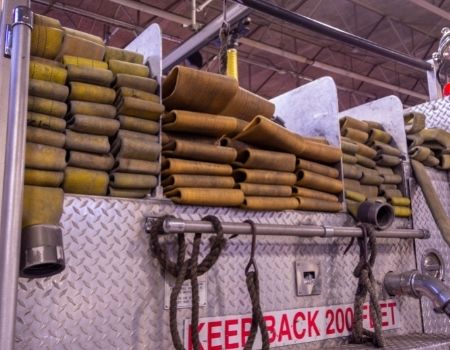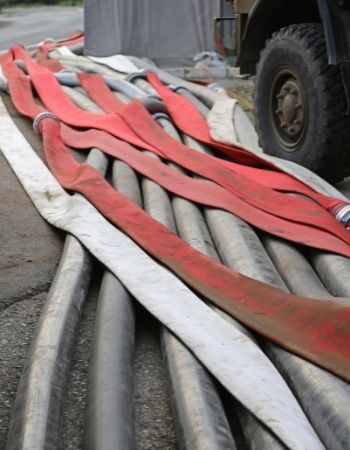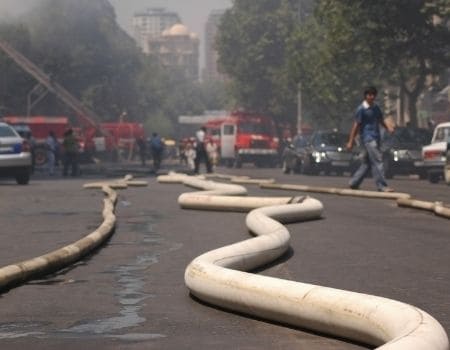To extinguish fires, firefighters will often have to lay a supply line. This allows for a more consistent supply of water. A firefighter will have to select a forward or reverse lay, but what’s the difference between the two?
A forward lay is a supply line laid from the fire hydrant or another source of water right to the fire. The opposite of that is the reverse lay, which is laying down the supply line from the source of the fire to the water supply.

If you’re looking for more information on forward vs. reverse lays, you’ve come to the right place. In this article, we’ll define both methods of laying a supply line, then explain the differences. We’ll even tell you how to efficiently use a forward lay and a reverse lay, so keep reading!
Table of Contents
What Is a Forward Lay?
Providing the quantity of water that firefighters need via a supply line might utilize a forward lay. The forward lay entails the firefighters laying supply line that’s several inches in length from the closest water source.
The source of water can include a tanker dump site or more commonly, a fire hydrant. The fire department then has the water supply they need to combat the fire. While the firefighter who connects the line to the fire hydrant and turns it on can’t place the line, they can advance the supply line if necessary.
To make the hydrant connection, a firefighter needs a spanner and adapters, so those pieces of equipment should be planned for ahead of time. The operator should refer to the firefighter by name when commanding them so the forward laying process goes smoothly.
Once the firefighter lays the forward line, they can gather with the others in the department.
There is a multitude of benefits to using a forward lay. The officer of the fire engine company has the time to assess the condition of the building while the firefighters wrap the supply line around the fire hydrant or tanker dump site.
They can also see the building from at least three sides to make a more accurate plan of attack.
What Is a Reverse Lay?
Okay, so that’s the forward lay, but what about reverse lay?
A reverse lay involves a firefighter laying down the supply line from the source of the fire such as a building to the fire hydrant or tanker dump site. The supply hose needs adapters, which means the fire engine must be configured for that setup.
Further, the hose line should have a wye. What is a wye? It’s a type of appliance that can split a hose line. What results is dual discharge gated male outlets and a female threaded inlet coupling.
The reason a wye is required is to allow for more hose line that fire departments will use if they arrive on the scene later. The recommended supply line lengths for a reverse lay setup with a wye are either two and a half inches, three inches, or five inches.
What’s the Difference Between a Forward and Reverse Lay?
Now that you better understand the forward and reserve lays, we can dive deeper into the differences between these two supply line setups.
Ease of Use
There’s a reason the forward lay is a lot more common among fire departments. The setup is regarded as easier to do. Firefighters don’t require as much equipment, and the fire crew doesn’t have to pre-plan to the same degree as they do with a reverse lay line.

Further, it doesn’t take nearly as much practice to perfect your forward laying technique as it does when laying a reverse line.
Convenience
Besides the speed and ease of deployment, another difference between forward and reverse lay lines is the convenience of doing so. Since you put the equipment nearer a fire building with a reverse lay, that means the fire engine can’t get as close as it can when forward laying the supply line.
This requires the fire crew to lug all that reverse lay equipment further. Depending on the distance of the equipment, moving it can be quite a big energy expenditure.
You must recall that firefighters who lay a supply line aren’t only doing that and then calling it a day. They regroup with their fellow firefighters in the building to begin actively combatting the blaze.
When a firefighter is already fatigued because they spent so much time wrestling with a reverse lay line or needlessly dragging equipment around, their ability to do their job falters. Now they’re less efficient at doing searches and rescues. They themselves could even need rescuing if they make too many missteps.
Visibility
Although laying reverse lines involve a lot of planning, the visibility that one has into the building before laying the supply line is a lot less. The fire crew can’t see most of the building’s four sides as they can when forward-laying line.
Since the operator can’t see the front of the building, that makes it hard to determine whether the wye and supply line are in adequate condition. The operator can go right on issuing commands assuming the reverse lay line is going fine when it isn’t despite all their plans.
Tips for Using Forward and Reverse Lays
As a firefighter, you’ll likely use both forward and reverse lays throughout your career. These tips will gear you up for success.
Have the Right Equipment
Preparing is integral whether it’s forward or reverse supply line you’re laying. You must ensure you have the equipment and tools you need before your fire crew arrives at the site of a fire. Whether that’s a wye, a spanner, or the correct adapters, each second a firefighter goes without these pieces of equipment when laying the line is precious seconds the fire is allowed to grow.
Limit Extraneous Effort
Do your best to plan the line-laying in such a way that no one is overextending themselves, especially for no conceivable reason.
If laying a reverse line would prevent the fire engine from getting too close to the line and thus cause a firefighter to have to carry around equipment, maybe that’s not your best route.

Instead, you might consider a forward lay. If that’s not possible, then perhaps you could configure the reverse lay in such a way where the engine could be closer to the equipment.
Let One Firefighter Lay the Line
Although properly laying a supply line can take some time and training to get right, it’s rarely more than a one-person job. Having fewer cooks in the kitchen, so to speak, can reduce confusion so the line-laying can happen swiftly.
Also, that’s one less firefighter who’s being taken away from putting out the blaze to lay down extra supply line.
Issue Clear Commands
If you’re the operator, we want to reiterate a point we made before about working with firefighters who are preparing forward lay or reverse lay supply lines.
You want to issue commands to the firefighter using their name. Ensure your commands are clear so the firefighter can easily comprehend what you’re asking of them and then get right to work
Secure the Line
You should also secure your water supply line, as this provides enough gallons per minute or GPM of water to the fire engines. If you forget or neglect to secure the line, a water tank can empty out fast.
For example, if the supply line was 1 ¾ inches and released water at 150 to 200 GPM for only around three or four minutes, a 500-gallon water tank would be empty.
What Are Split Lays?
In some instances, your fire department might use neither forward lays or reverse lays, but rather, split lays, which are sometimes called blind alleys.
A split lay is when a firefighter drops a hose at a predetermined point, such as the corner of two intersecting streets, and then ties the line and brings it to the closest source of water, which is often a fire hydrant.
The first fire engine on the scene would release their supply line and then the second fire engine does the same. The two hose lines are at the center point.
With enough water for both engines, this prevents the need for a third or a fourth fire engine from showing up and creating even less space in what’s an already tight situation.
If your fire department is in a situation where space is limited, such as a tight street, an alley, or a narrow path, then split lays are highly recommended.
You should also consider a split lay if combatting a fire on a dead-end street or one with limited access, such as when a road closure from construction limits the way in and out.
When determining where to lay the supply line, you can select from a forward lay, reverse lay, or split lay. Each has its advantages and is appropriate in different scenarios. By learning how to lay supply line, you’ll become a more efficient firefighter!